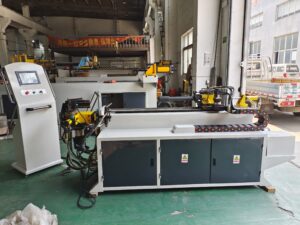In the grand orchestra of industrial machinery, the pipe bender stands as a maestro, shaping and molding pipes into graceful curves that serve various applications across numerous industries. From plumbing to automotive, aerospace to shipbuilding, the pipe bender’s role is indispensable.
The Core Components – A Symphony of Parts
1.1 The Frame: The Backbone of Sturdiness
At the heart of any pipe bender lies a robust frame, typically constructed from high-grade steel. Its design must withstand the immense forces exerted during bending operations, ensuring stability and durability over years of service.
1.2 The Bending Head: The Artisan’s Hand
The bending head, akin to the artisan’s hand, is responsible for the actual bending process. It comprises a set of rollers or dies that grip the pipe securely.
1.3 The Clamping Mechanism: Holding Steady
Adjacent to the bending head, the clamping mechanism holds the pipe firmly in place, preventing slippage during the bending process. This component ensures that the pipe remains stable, allowing for precise and controlled bending. The clamping mechanism is often adjustable, accommodating pipes of different diameters and materials.
1.4 The Drive System: Powering the Motion
The drive system is the engine that powers the bending operation. It can take various forms, including electric motors, hydraulic systems, or even manual cranks on smaller models. The choice of drive system influences the speed, force, and efficiency of the bending process.
Section 2: The Control Panel: Where Man Meets Machine
2.1 The Interface: Bridging the Gap
The control panel acts as the interface between the operator and the machine, allowing for precise control over the bending parameters. Modern pipe benders often feature digital interfaces that display critical data such as bending angle, speed, and pressure. This information empowers operators to make informed adjustments, enhancing accuracy and productivity.

2.2 Safety Features: Ensuring Peace of Mind
Safety is paramount in any industrial setting. Advanced pipe benders incorporate safety features such as emergency stop buttons, protective guards, and automated shut-off mechanisms.
Section 3: Customization and Adaptability: Tailoring the Machine to Your Needs
3.1 Modular Design: Flexibility in Function
The modular design of many modern pipe benders allows for easy customization. Operators can swap out components like dies and rollers to accommodate different pipe sizes and materials.
3.2 Software Integration: Enhancing Capabilities
Incorporating software into the pipe bending process opens up new possibilities for automation and precision. Advanced software can calculate bending parameters based on inputted pipe specifications, eliminating the need for manual calculations and reducing the likelihood of human error.




